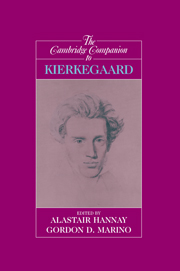Book contents
- Frontmatter
- Introduction
- 1 Out with It!
- 2 The unknown Kierkegaard
- 3 Art in an age of reflection
- 4 Kierkegaard and Hegel
- 5 Neither either nor or
- 6 Realism and antirealism in Kierkegaard's Concluding Unscientific Postscript
- 7 Existence, emotion, and virtue
- 8 Faith and the Kierkegaardian leap
- 9 Arminian edification
- 10 “Developing” Fear and Trembling
- 11 Repetition
- 12 Anxiety in The Concept of Anxiety
- 13 Kierkegaard and the variety of despair
- 14 Kierkegaard's Christian ethics
- 15 Religious dialectics and Christology
- 16 The utilitarian self and the "useless" passion of faith
- Bibliography
- Index
3 - Art in an age of reflection
Published online by Cambridge University Press: 28 May 2006
- Frontmatter
- Introduction
- 1 Out with It!
- 2 The unknown Kierkegaard
- 3 Art in an age of reflection
- 4 Kierkegaard and Hegel
- 5 Neither either nor or
- 6 Realism and antirealism in Kierkegaard's Concluding Unscientific Postscript
- 7 Existence, emotion, and virtue
- 8 Faith and the Kierkegaardian leap
- 9 Arminian edification
- 10 “Developing” Fear and Trembling
- 11 Repetition
- 12 Anxiety in The Concept of Anxiety
- 13 Kierkegaard and the variety of despair
- 14 Kierkegaard's Christian ethics
- 15 Religious dialectics and Christology
- 16 The utilitarian self and the "useless" passion of faith
- Bibliography
- Index
Summary
INTRODUCTION
In The Point of View for My Work as an Author Kierkegaard uses the concept of “the aesthetic” to establish one of the fundamental divisions of his authorship. Even more significantly, he seems to give to the question of whether the authorship is “aesthetic” or “religious” a pivotal place in defining the correct “point of view” from which to understand that authorship as a whole. We might therefore conclude that a concern with “the aesthetic” lies at the very heart of Kierkegaard's intellectual project.
But what is meant by “the aesthetic” here? When the aesthetic is defined as an “existence-sphere” in opposition to the religious, are we to assume that Kierkegaard has a particular grudge against the life-styles of artists and art lovers? Does writing a novel or going to the theatre exclude those who do such things from living ethically or religiously? Kierkegaard himself seems to have denied this quite conclusively in references to the feuilleton article The Crisis [and a Crisis] in the Life of an Actress he wrote in 1847, which paid tribute to Madame Heiberg's triumphant performance as Juliet, nineteen years after she had established her reputation as one of the stars of the Danish stage in that very role. The significance of this article, he claims, is that it refutes the view that “religion and Christianity are something one first has recourse to when one grows older” (PV 31). It showed that the religious aspect of his authorship did not simply replace the aesthetic. “That little article” (as he referred to it on several occasions) showed that an appropriate engagement with art could coexist alongside the religious.
- Type
- Chapter
- Information
- The Cambridge Companion to Kierkegaard , pp. 76 - 100Publisher: Cambridge University PressPrint publication year: 1997
- 3
- Cited by



